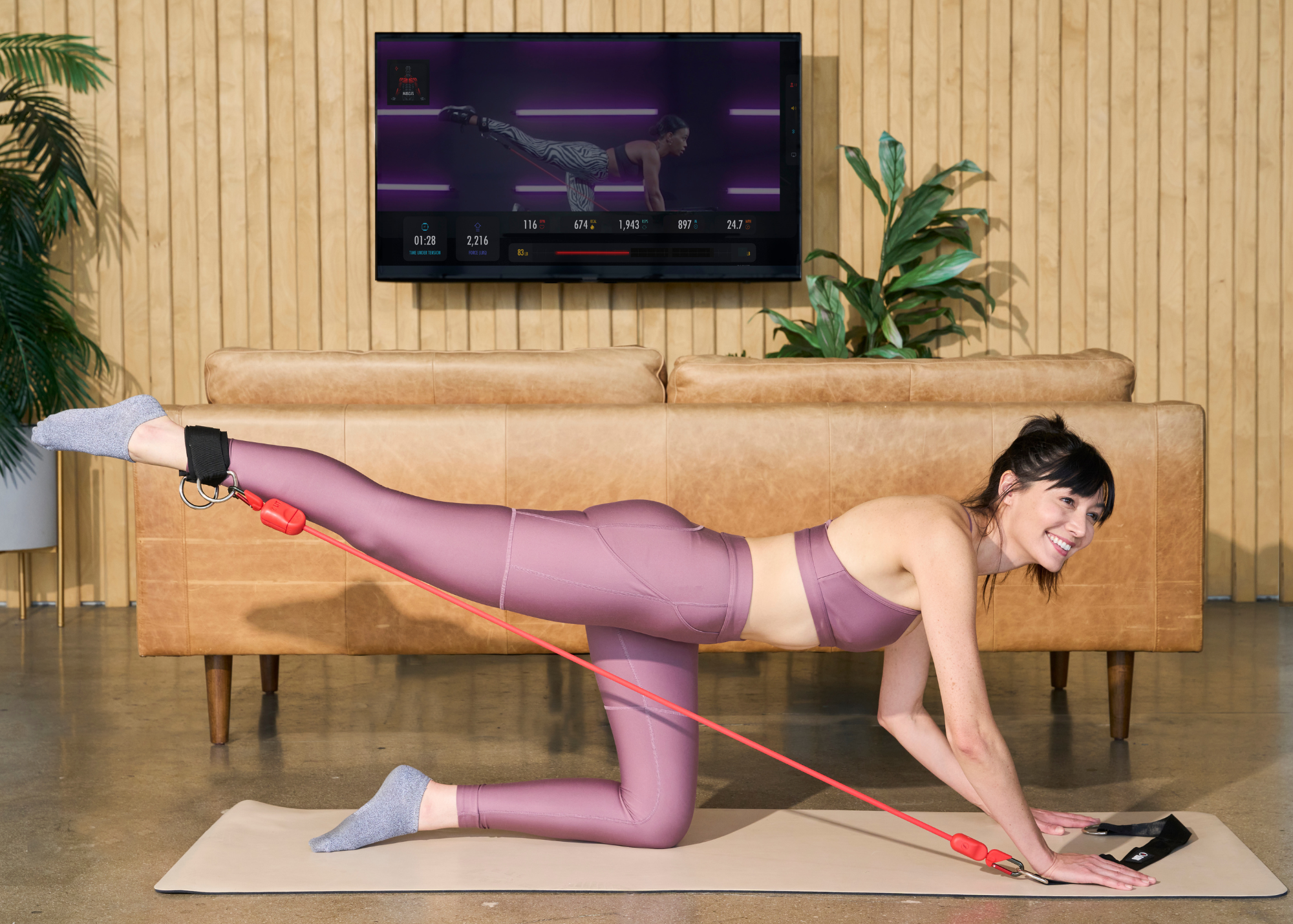You don't need to sign up for an expensive gym membership to work up that booty. We have put together a list of workouts for you to follow to build strength and get results!
Arguably, the most underrated and inexpensive home gym equipment you can own, resistance bands can effectively target and strengthen your glute muscles. The small, bendable, and elastic bands are great for glute exercises that fire up your glutes and posterior muscles from all angles.
This article will explore how resistance bands exercise can build strength in your glutes, the benefits of butt workouts, and exercises that can help to build glute muscles.
Can resistance bands build glute strength?
Resistance bands work by increasing the resistance during eccentric and concentric exercise movements. It makes muscles work harder, stimulating their growth and strength. Glutes is a collective term that refers to three large muscle groups in the back region – the gluteus minimus, gluteus medius, and gluteus maximus.
The gluteus maximus is the largest of the three and one of the most important muscle groups for supporting daily functioning. However, the struggle to keep the booty in shape arises because long hours of sitting weaken the glute muscles. It can tighten the hip flexors, which results in pain in the legs, ankles, and back.
Glute muscles are essential to strengthen the lower body and maintain an upright posture. Targeting glute muscles with free weights is problematic unless you have specific gym equipment like a cable or gym thrust machine. Resistance bands, on the contrary, are highly versatile that can target all three glute muscle groups.
You can target different muscles with glute band exercises and improve mind-muscle connection and activation of more muscle fibers. Incorporating a resistance band butt workout into your routine can get you strong and toned glutes.
Benefits of using a resistance band for glutes exercises
Resistance bands are gentler on joints and activate more muscle fibers. Also, they increase blood flow to the backside muscles before a high-intensity workout. Also, as resistance bands maintain consistent tension on the muscles during the exercise, they prevent muscle imbalance injuries.
Targeting all three major muscle groups is much easier with glute band exercises. You can do various exercises targeting lower and upper body muscles and the core. If you have never trained your glutes before, it is best to start with resistance bands.
Five resistance band glute exercises
1. Lateral Band Walk

- Keep the foot firm, and place the band around your ankles.
- Get down in a shallow squat position (bend one-fourth of a full squat), keeping your feet hip-width apart. You can choose to keep your hands on your hips or your chest.
- Now take one step to your right, moving your right foot out so your feet are more expansive than hip-width. Move your left foot towards the right foot such that the gap between the feet is hip-width apart again.
- Take three steps to the right and three to the left to complete one rep.
Note: To maintain the correct posture during this booty resistance band exercise, keep your weight in the center, keep your core engaged, and maintain constant tension in the band.
2. Standing Glute Kickback

- Stand with your feet hip-width apart, resistance band looped around your ankles, and keep your core engaged.
- Keeping your hands on your chest, concentrate your body weight on your left leg. Lift the right toes off the floor about an inch and move them behind your left heel diagonally to stretch the band and create tension.
- Kick your right leg backward by squeezing your core. Keep your pelvis under and knees straight.
- Return to the second position to tap the floor, maintaining the resistance in the band.
- Complete reps on the right side before moving to the left side.
Note: This resistance band glute workout requires maintaining your back straight. If you feel your back is arching, keep the movement small. Also, ensure that the leg kicking has no body weight over it.
3. Squat to Lateral Leg Lift

- Loop the resistance band around your thighs just above the knees.
- With your feet hip-width apart, bring your hands to your chest or hips.
- Bend down into a squat with knees bent 90 degrees.
- Next, lift your right leg to the side, ensuring your knee is straight.
- Return the right leg to the floor in the controlled descent.
- Squat again and follow it with standing up, putting your left leg out on the side, and keeping your knee straight. Return the left leg to the floor and squat again immediately.
- This is one rep.
Note: Keep your core engaged and your chest lifted, and do not arch your back. Make the movement small if it's hard to keep your back straight.
4. High Plank Leg Lifts

- Wrap the band around the ankles and get in a push-up or high plank position, keeping your back straight.
- To engage your core, squeeze your right glute and lift your right leg towards the ceiling without arching your back. Hold for a few seconds, and then bring it down.
- Repeat with your left leg, engaging the left glute muscles. That's one rep.
Note: Do not allow your hips to pike up or drop. Pull up your belly towards your spine to maintain the proper posture and engage the core.
5. Banded Glute Bridge Abductions

- Lie on your back with a resistance band above your knees. Bend the knees and keep your feet firm on the floor with a shoulder-width gap between them. Move your heels as close to your butt as you can. Keep your back flat against the floor.
- Squeeze your glutes, lifting your hips towards the ceiling with force driving through the feet.
- You must form a diagonal line from knees to shoulder when you reach the top with your hips. Also, drive knees out against the band, making space wider than shoulder width.
- Bring your knees back to shoulder width and gradually lower your back to the floor.
- That's one rep.
Note: You must maintain a slight posterior pelvic tilt to ensure your back is not arching throughout this resistance band booty workout.
Sample resistance band glute workout
- The sample resistance band glute workout we share is appropriate for beginners and experienced users. If you are new to these booty band exercises, you must do each for 45 seconds with a 15 seconds rest between moves. Intermediate and advanced users should do these resistance band exercises for glutes 20 reps each with as little rest as possible in between.
- You should rest for 60 seconds at the end of the circuit.
- Start with a 5-minute warm-up session of stretching to loosen the muscles.
Lateral Band Walk – 3 sets
Standing Glute Kickback - 3 sets
Squat to Lateral Leg Lift – 2 sets
High Plank Leg Lifts – 2 sets
Banded Glute Bridge Abductions – 3 sets
How to choose the correct resistance band for glute exercises?
Resistance bands are of multiple types, and you must know which one to choose for butt exercises with bands. They can be short, long, looped, and unlooped.
You must select the unlooped bands for resistance band butt workouts because they are highly versatile. You can loop these resistance bands into several configurations to vary their resistance. Furthermore, they are suitable for cooldown exercises, warm-ups, and physiotherapy movements.
Which resistance band is best for glute workouts?
LIT Axis smart resistance bands set is a complete home gym system that can replace any cable machine. Their clever design and provided accessories ensure you can use them for glute band exercises, warm-up exercises, muscle building, and mobility training.

~[[lit-axis-cherry]]

Where to place resistance bands for glutes?
For effective glute muscle building with resistance bands, strategic placement is key. Position the resistance band either above the kneecap or at the mid-thigh level for optimal results. To intensify the workout and target the glutes even more, consider placing the band just below the knees. This placement engages the muscles at a lower point in the range of motion, providing a deeper activation. Experiment with these band placements to discover what works best for your glute training routine.
Conclusion
Resistance bands are excellent for activating the muscles in the glutes. By providing low-impact and consistent resistance training, the bands can target all three muscle groups in the glutes for that perfect booty shape.
However, you must be patient with any resistance band glute workout, as the results will be slower than expected with traditional weight training machines. Still, they will happen in a more sustainable and injury-free manner.





